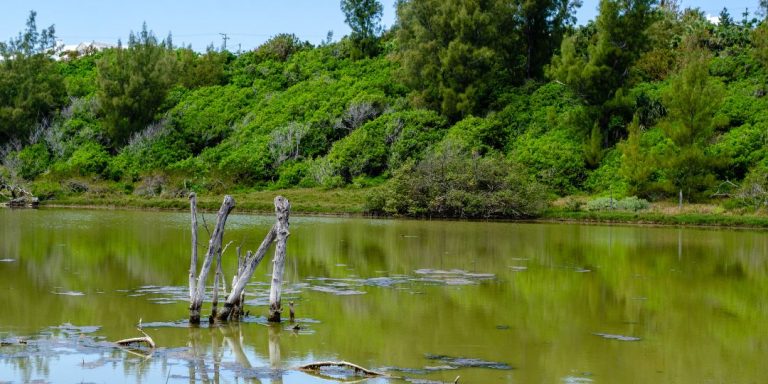Last updated on March 29th, 2025 at 12:30 pm
Brackish water is a type of water that has a salt concentration level between that of freshwater and seawater. It’s characterized by a moderate level of salinity, which is more than freshwater but significantly less than seawater.
Brackish water can naturally occur in areas where freshwater from rivers or streams meets saltwater from the ocean or sea, such as in estuaries, mangroves, and salt marshes. Additionally, certain underground waters, like some aquifers, can also be brackish due to a mix of freshwater and intruding seawater or ancient salt deposits.
The exact salinity can vary, but brackish water typically contains between 0.5 to 30 grams of salt per liter.
What density is brackish water?
Density is a measure of how much mass is contained in a given volume. When we discuss the density of water, it’s influenced by several factors, with salinity (or salt content) being a primary one.
Brackish water has a salt concentration between that of freshwater and seawater. Freshwater has a density of approximately 1.000g/cm31.000g/cm3 (or 1000kg/m31000kg/m3) at 4°C, while seawater, with a typical salinity of 35 parts per thousand (ppt), has a density of about 1.025g/cm31.025g/cm3 (or 1025kg/m31025kg/m3) at the same temperature.
Given that brackish water’s salinity falls between freshwater and seawater, its density would also be between 1.000g/cm31.000g/cm3 and 1.025g/cm31.025g/cm3. The exact density of brackish water depends on its specific salinity, temperature, and other dissolved substances.
What are the TDS range for brackish water?
TDS, or Total Dissolved Solids, is a crucial parameter for defining water types.
- TDS Range: Brackish water generally has a TDS value ranging from 1,000 to 10,000 mg/L.
· Habitats Influenced by Brackish Water:
Brackish water, given its intermediate salt content, forms unique environments where both freshwater and marine species can thrive. The transitional nature of these habitats often results in high biodiversity, making them ecologically significant.
- Estuaries: Estuaries are areas where freshwater from rivers or streams meets and mixes with saltwater from the ocean or sea.
- Significance: These are among the most productive ecosystems in the world. They act as nurseries for many marine species, offering a protective environment for juvenile fish and other aquatic life to grow before venturing out into the open sea.
- Biodiversity: Estuaries support diverse communities ranging from aquatic plants, fish, shellfish, to bird species.
- Mangroves: Mangroves are tropical or subtropical tidal forest ecosystems found along coastlines, characterized by trees and shrubs that can tolerate high salinity levels.
- Significance: They act as a buffer, reducing coastal erosion, protecting inland areas from storms and tsunamis, and filtering pollutants from water.
- Biodiversity: Mangroves are home to a variety of species, including crabs, mollusks, fish, and birds. Their intricate root systems provide a refuge for young marine animals.
- Salt Marshes: Salt marshes are coastal wetlands that are flooded and drained by saltwater, typically brought in by tides.
- Significance: They play a crucial role in filtering pollutants from the water, reducing flooding by storing stormwater, and preventing shoreline erosion.
- Biodiversity: These marshes support a variety of plant species adapted to high salinity and changing water levels. They also host numerous bird species, crustaceans, and fish.
- Lagoons: Lagoons are shallow coastal water bodies separated from larger bodies of water (like oceans) by barriers such as sandbars, coral reefs, or barrier islands.
- Significance: Lagoons often act as buffer zones, protecting coastlines from strong ocean waves and currents. They also serve as habitats for many species adapted to varying salinity levels.
- Biodiversity: Depending on their location and the degree of connectivity to open waters, lagoons can support a mix of freshwater, marine, and uniquely brackish-adapted species.
2. What is the methods for brackish water treatment?
Brackish water, with its intermediate salt content, requires specialized treatment to make it suitable for various applications, especially for potable use. Brackish water treatment aims to reduce its salinity, remove impurities, and make it safe for consumption and other purposes.
- Reverse Osmosis (RO): This is the most commonly used method for brackish water treatment. RO involves forcing water through a semi-permeable membrane under pressure. This membrane allows water molecules to pass through but restricts most dissolved salts, impurities, and contaminants, resulting in purified water on the other side.
- Advantages: Reverse Osmosis can effectively reduce the Total Dissolved Solids (TDS) to acceptable levels for drinking. It’s efficient and widely available.
- Electrodialysis (ED): Electrodialysis uses electrical potential to drive the movement of ions through selective membranes, which separate and concentrate them away from the water. It’s especially effective for brackish water with lower salinity levels.
- Advantages: Less energy-intensive for waters with moderate salinity compared to RO.
- Ion Exchange: Ion exchange resins are used to replace undesirable ions (like those of calcium, magnesium, or certain heavy metals) with other ions (commonly hydrogen or hydroxide).
- Advantages: Useful for specific ion removal and softening of water.
- Distillation: While less common for brackish water and more associated with seawater, distillation involves heating the water to create vapor and then condensing the vapor back into a liquid in a separate chamber. This process separates the water from most of its impurities.
- Advantages: Produces very pure water, but it’s more energy-intensive.
- Filtration and Sedimentation: Before advanced treatments like RO or ED, brackish water might undergo basic filtration processes to remove sediments, particulates, and certain organic materials.
- Advantages: Prepares water for subsequent treatment steps and improves overall water quality.
What is the process of desalination of brackish water by reverse osmosis?
Desalination is the process of removing dissolved salts from water to produce freshwater suitable for drinking, irrigation, and other purposes. While there are various methods of desalination, reverse osmosis desalination has emerged as a prominent and effective approach, especially for brackish water sources.
- Pre-treatment: Before reaching the RO membrane, brackish water undergoes pre-treatment to remove sediments, particulates, and certain chemicals that might damage or foul the membranes. This can involve sand filtration, activated carbon filters, and chemical dosing.
- High-Pressure Pumping: For the reverse osmosis process to work effectively, the water needs to be pressurized. This pressurized water is then passed through the RO membranes.
- Membrane Filtration: As the pressurized water flows through the membranes in the commercial reverse osmosis water filtration system, dissolved salts and impurities are held back, while clean water permeates through.
- Post-treatment: The permeate or treated water may require pH adjustment, remineralization, or disinfection before it’s ready for end-use.
- Commercial Applications:
- Relevance: Given the efficiency and scalability of RO, commercial reverse osmosis water filtration systems have become widespread in various sectors. From industrial applications, public water supply schemes to dedicated seawater desalination systems in coastal regions, RO caters to a vast array of water purification needs.
- Flexibility: The modular nature of RO systems allows for scaling up or down based on the volume of water required. This adaptability has made it a favored choice for both brackish water and seawater desalination.
3. Solutions by Ampac USA:
- Water Filtration System for Water Store:
Ampac USA has developed cutting-edge solutions to address the growing need for water treatment. Their water filtration system for water store is tailor-made for businesses, ensuring a consistent supply of purified water. Moreover, in areas where immediate potable water is required, the emergency desalination water maker proves invaluable. Ampac USA’s comprehensive range also includes specialized water store equipment to cater to a broad spectrum of needs.
Conclusion:
As our global water challenges intensify, turning to solutions like brackish water treatment becomes paramount. Through advanced technologies and robust systems like those from Ampac USA, we’re paving the way for a more hydrated and sustainable future.











